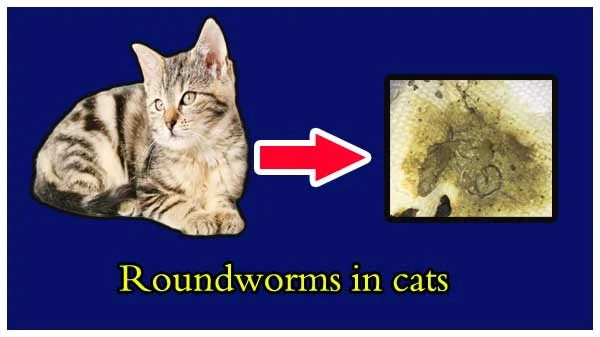 |
| Roundworms in cats |
Roundworms in cats
The internal parasites of the cat, better known under the generic name of "intestinal worms", can infest the cat at any time and cause sometimes serious disorders.
There are two categories of these parasites: roundworms, and flatworms like tapeworm.
Contamination is by ingestion of eggs or larvae and is more likely to occur in cats that come out, since it can happen through the pests (rats) that the tomcat is led to hunt and to eat. What are the characteristics of the different types of parasites, how to detect their presence and what risks do they represent?
Roundworms, responsible for toxocariasis
Roundworms are round worms of cylindrical shape, 4 to 5 cm long. They can cause vomiting, diarrhea and sometimes intestinal obstruction, especially in the kittens. They weaken the body of the cat, which then shows signs of fatigue or even depression and loss of appetite.
The eggs of these parasitic worms are found in the faeces of the animal and become larvae capable of migrating in the intestine, then to other organs such as the liver, the heart, the lungs and even into the udders of the cat , from where they can be passed on to kittens through the milk. Read also: What diseases of cats are transmissible to humans?
Roundworms pose a risk of zoonosis, that is, massive contamination of the environment, and can also infest humans. They therefore constitute a danger to public health, especially when children ingest the eggs.
Roundworms can go as far as causing respiratory and eye disorders depending on where they migrate: in the event of heavy infestation, we also speak of toxocarosis.
Roundworms can go as far as causing respiratory and eye disorders depending on where they migrate: in the event of heavy infestation, we also speak of toxocarosis.
Hookworms, specific cat worms
This type of worm is round, 1 to 2 cm long and red in color. It takes up residence in the digestive tract, where it feeds on blood from the walls, thereby causing bleeding observable in the stools and anemia.
Hookworms can infect humans through the lungs and skin, and their larvae sometimes cause rashes. Brownish diarrhea and dark, tarry stools are signs of their presence in the body. They can cause serious damage to the intestine In the long term.
Hookworms can infect humans through the lungs and skin, and their larvae sometimes cause rashes. Brownish diarrhea and dark, tarry stools are signs of their presence in the body. They can cause serious damage to the intestine In the long term.
Whipworms, rarer roundworms
Less common in cats, whipworms are found in the large intestine and the cecum (first part of the colon). They are responsible for diarrhea sometimes accompanied by bleeding. The whipworms are round worms of 3 to 4 cm approximately, coming rather from dogs. They also feed on the blood of their host and are more common in animals living in communities.
Tapeworm of the cat (tapeworm)
This flatworm is whitish in color and can measure up to 50 cm in adulthood! It evolves in the digestive tract of animals where it draws nutrients. The tapeworm consists of rings (segments) which detach and are found in the cat's droppings, but also at the level of the anus, resembling grains of rice. To detect an infestation, it will be necessary to inspect this area and observe the stool carefully.
The tapeworm parasite cycle often takes place via flea larvae, so regular flea treatment is recommended to prevent infestations.
The tapeworm causes diarrhea, vomiting, weight loss and general fatigue in cats. Another sting of the tapeworm is a biting, dull coat, caused by poor absorption of nutrients and dehydration resulting from parasitic infestation. The tapeworm is also transmitted to humans, where it can cause similar symptoms: diarrhea, lack of appetite, weight loss, etc. It can also cause bulimic behaviors. Read also: Diagnosing and Preventing Feline Heartworm Disease.
The tapeworm causes diarrhea, vomiting, weight loss and general fatigue in cats. Another sting of the tapeworm is a biting, dull coat, caused by poor absorption of nutrients and dehydration resulting from parasitic infestation. The tapeworm is also transmitted to humans, where it can cause similar symptoms: diarrhea, lack of appetite, weight loss, etc. It can also cause bulimic behaviors. Read also: Diagnosing and Preventing Feline Heartworm Disease.
Protozoa or coccidia
These flatworms lodge on the lining of the small intestine and can cause enteritis (inflammation of the intestine). They are responsible for the famous toxoplasmosis, a benign condition in cats, but dangerous for pregnant women. This parasite will multiply in the digestive tract by dissemination of eggs (oocysts).
The signs of infestation in cats are the same as for most digestive parasites: vomiting, diarrhea, fatigue, swelling stomach ... The protozoan at the origin of toxoplasmosis belongs to the category of coccidia, but it does There are other kinds responsible for acute enteritis mainly in kittens. Contamination is by ingestion of microscopic cysts where the eggs are encapsulated, and which can be present almost everywhere in the environment but also in the meat coming from contaminated animals.
How to prevent worm infestation?
A regular deworming (two to four times per year depending on the cat's lifestyle) is the only solution to guard effectively against intestinal parasites. If your tomcat comes out, it is necessary to deworm it every new season. Kittens, which are more susceptible to infestation, should be treated every two weeks in their first month, and then each month until they are six months old.
Checking with your veterinarian in case of doubt is the best reflex to have: the latter will provide you with the product and dosage suitable for your animal, depending on its age, weight and lifestyle.
For more details and information about worms, click here.
